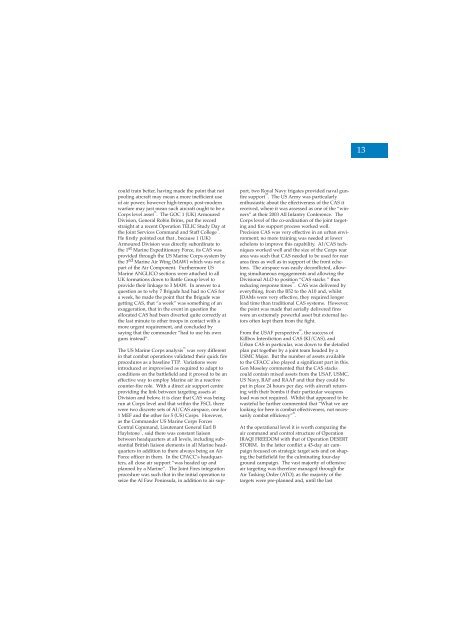Volume 6 No 4 - Royal Air Force Centre for Air Power Studies
Volume 6 No 4 - Royal Air Force Centre for Air Power Studies
Volume 6 No 4 - Royal Air Force Centre for Air Power Studies
You also want an ePaper? Increase the reach of your titles
YUMPU automatically turns print PDFs into web optimized ePapers that Google loves.
13<br />
could train better, having made the point that not<br />
pooling aircraft may mean a more inefficient use<br />
of air power; however high-tempo, post-modern<br />
warfare may just mean such aircraft ought to be a<br />
Corps level asset 74 . The GOC 1 (UK) Armoured<br />
Division, General Robin Brims, put the record<br />
straight at a recent Operation TELIC Study Day at<br />
the Joint Services Command and Staff College 75 .<br />
He firstly pointed out that , because 1 (UK)<br />
Armoured Division was directly subordinate to<br />
the 1 st Marine Expeditionary <strong>Force</strong>, its CAS was<br />
provided through the US Marine Corps system by<br />
the 3 rd Marine <strong>Air</strong> Wing (MAW) which was not a<br />
part of the <strong>Air</strong> Component. Furthermore US<br />
Marine ANGLICO sections were attached to all<br />
UK <strong>for</strong>mations down to Battle Group level to<br />
provide their linkage to 3 MAW. In answer to a<br />
question as to why 7 Brigade had had no CAS <strong>for</strong><br />
a week, he made the point that the Brigade was<br />
getting CAS, that “a week” was something of an<br />
exaggeration, that in the event in question the<br />
allocated CAS had been diverted quite correctly at<br />
the last minute to other troops in contact with a<br />
more urgent requirement, and concluded by<br />
saying that the commander “had to use his own<br />
guns instead”.<br />
The US Marine Corps analysis 76 was very different<br />
in that combat operations validated their quick fire<br />
procedures as a baseline TTP. Variations were<br />
introduced or improvised as required to adapt to<br />
conditions on the battlefield and it proved to be an<br />
effective way to employ Marine air in a reactive<br />
counter-fire role. With a direct air support centre<br />
providing the link between targeting assets at<br />
Division and below, it is clear that CAS was being<br />
run at Corps level and that within the FSCL there<br />
were two discrete sets of AI/CAS airspace, one <strong>for</strong><br />
1 MEF and the other <strong>for</strong> 5 (US) Corps. However,<br />
as the Commander US Marine Corps <strong>Force</strong>s<br />
Central Command, Lieutenant General Earl B<br />
Haylstone 77 , said there was constant liaison<br />
between headquarters at all levels, including substantial<br />
British liaison elements in all Marine headquarters<br />
in addition to there always being an <strong>Air</strong><br />
<strong>Force</strong> officer in them. In the CFACC’s headquarters,<br />
all close air support “was headed up and<br />
planned by a Marine”. The Joint Fires integration<br />
procedure was such that in the initial operation to<br />
seize the Al Faw Peninsula, in addition to air support,<br />
two <strong>Royal</strong> Navy frigates provided naval gunfire<br />
support 78 . The US Army was particularly<br />
enthusiastic about the effectiveness of the CAS it<br />
received, where it was assessed as one of the “winners”<br />
at their 2003 All Infantry Conference. The<br />
Corps level of the co-ordination of the joint targeting<br />
and fire support process worked well.<br />
Precision CAS was very effective in an urban environment;<br />
no more training was needed at lower<br />
echelons to improve this capability. AI/CAS techniques<br />
worked well and the size of the Corps rear<br />
area was such that CAS needed to be used <strong>for</strong> rear<br />
area fires as well as in support of the front echelons.<br />
The airspace was easily deconflicted, allowing<br />
simultaneous engagements and allowing the<br />
Divisional ALO to position “CAS stacks ” thus<br />
reducing response times 79 . CAS was delivered by<br />
everything, from the B52 to the A10 and, whilst<br />
JDAMs were very effective, they required longer<br />
lead time than traditional CAS systems. However,<br />
the point was made that aerially delivered fires<br />
were an extremely powerful asset but external factors<br />
often kept them from the fight.<br />
From the USAF perspective 80 , the success of<br />
Killbox Interdiction and CAS (KI/CAS), and<br />
Urban CAS in particular, was down to the detailed<br />
plan put together by a joint team headed by a<br />
USMC Major. But the number of assets available<br />
to the CFACC also played a significant part in this.<br />
Gen Moseley commented that the CAS stacks<br />
could contain mixed assets from the USAF, USMC,<br />
US Navy, RAF and RAAF and that they could be<br />
put in place 24 hours per day, with aircraft returning<br />
with their bombs if their particular weapons<br />
load was not required. Whilst that appeared to be<br />
wasteful he further commented that “What we are<br />
looking <strong>for</strong> here is combat effectiveness, not necessarily<br />
combat efficiency” 81 .<br />
At the operational level it is worth comparing the<br />
air command and control structure of Operation<br />
IRAQI FREEDOM with that of Operation DESERT<br />
STORM. In the latter conflict a 43-day air campaign<br />
focused on strategic target sets and on shaping<br />
the battlefield <strong>for</strong> the culminating four-day<br />
ground campaign. The vast majority of offensive<br />
air targeting was there<strong>for</strong>e managed through the<br />
<strong>Air</strong> Tasking Order (ATO), as the majority of the<br />
targets were pre-planned and, until the last
















